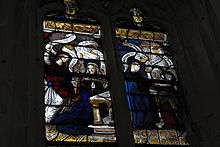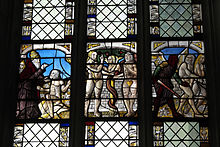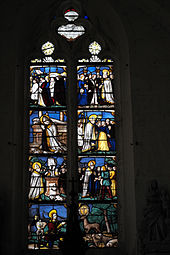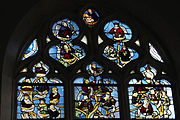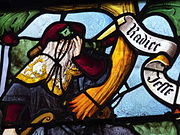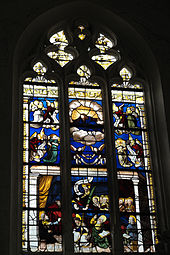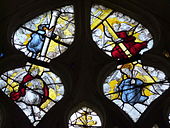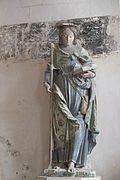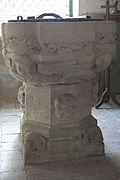Notre-Dame-en-sa-Nativité (Puellemontier)
The Catholic parish church of Notre-Dame-en-sa-Nativité in Puellemontier , a district of the municipality of Rives Dervoises in the Haute-Marne department in the French region of Grand Est , dates back to a Romanesque church from the 12th century. The church has a series of leaded glass windows from the early 16th century. In 1992 the church dedicated to the birth of Mary was added to the list of architectural monuments in France as Monument historique .
history
Around 670, St. Bercharius, who later became the abbot of the Benedictine abbey of Montier-en-Der , founded a convent in Puellemontier. The name of the place is derived from this Puellarum monasterium (Latin: puella , girl).
The current church was built in the 12th century. The central nave and the two side aisles have been preserved from this building. The eastern nave yoke dates back to the early 12th century. At the end of the 12th or beginning of the 13th century the church was extended to the west. In the 19th century the originally flat roofed nave was vaulted.
In the early 16th century the two-aisled transept and the choir were built . In 1527 the apse was glazed and in 1531 the lead glass windows were installed in the south arm of the transept.
In the 19th century the west facade was changed and the north portal renewed. After the storm in 1999 the roof had to be repaired and in 2003 the collapsed bell tower was rebuilt.
architecture
Exterior construction
A roof turret, covered with wooden shingles and fitted with a clock, rises above the west facade . The bell tower above the crossing is crowned by a pointed helmet and is also covered with shingles.
The west facade is structured by two strong buttresses and is broken through by three portals and in the middle by three arched windows. The middle portal of the west facade was redesigned in the 13th century. It is surrounded by archivolts resting on slender pillars. The portal has a tympanum that is framed by a three-pass . The two side portals were renewed in the 15th century. Instead of a tympanum, they are pierced by tracery windows.
inner space
The three-aisled nave is divided into three bays . A two-nave transept adjoins the nave . The choir opens into an apse with a polygonal end. The transept and choir have ribbed vaults with carved keystones . Instead of capitals , the pillars are decorated with pillar rings that have a braided ribbon decoration and small figures. A door in the choir leads to the sacristy , the lintel of which is occupied by two angels holding a coat of arms. Several piscinas have also been preserved in the choir .
Renaissance window
- Window 0: Life of Mary
The middle choir window was probably created around 1527 like the right choir window. It was partially supplemented in the 19th century. Both windows are dedicated to the life of Mary . The individual scenes show: the birth of Mary (bottom left), the Annunciation (top left), the Visitation (top right), the presentation of Jesus in the temple (bottom right), the coronation of Mary in the tracery .
- Window 1: Life of Mary
The scenes in the right choir window depict the meeting of Anna and Joachim at the Golden Gate (top left), the Annunciation to Joachim (top right), the birth of Jesus (bottom left) and the adoration of the Magi (bottom right).
- Window 2: Passion
The window is dated around 1507. The left lancet shows Jesus and the sleeping disciples on the Mount of Olives, above his capture and his crucifixion. On the right lancet above you can see the Descent from the Cross , below it the resurrection and below the meeting of Jesus with Mary Magdalene ( Noli me tangere ) at the empty tomb.
- Window 3: Saint Catherine, Saint Margaret and Saint Barbara
On the window from the first quarter of the 16th century, the three saints and martyrs, who are also counted among the fourteen helpers in need , are depicted with their attributes : St. Catherine with sword and wheel, St. Margaret with a dragon and St. Barbara with a tower.
- Window 4: Adam and Eve
The window is dated around 1520. The scene on the left shows God the Father with the papal crown on his head with Adam and Eve . The middle scene depicts the fall of man . Eve hands Adam an apple, between the two of them the snake, represented with a woman's head, winds around the tree of knowledge . On the right scene a red angel is driving Adam and Eve out of paradise .
- Window 5: Legend of St. Hubertus
Most of the scenes in the window were added by Louis-Germain Vincent-Larcher in 1865. From the first quarter of the 16th century, the tips of the lancets with the Christ and Mary monograms have been preserved, as well as the lower scene in which the crucified Christ appears to St. Hubertus in the antlers of a deer.
- Window 6: Root Jesse
The window depicting the root of Jesse dates from 1531. It was restored in 1863 by the glass painters Erdmann and Kremer in Paris, as can be seen from the inscription in the tracery.
- Window 7: Mary's death
The window from the first quarter of the 16th century depicting the death of the Virgin was restored by Louis-Germain Vincent-Larcher around 1863. In the lower area of the window, Mary is lying on her death bed, surrounded by the apostles, in the foreground James the Elder , who can be recognized through his pilgrim's staff and hat with a scallop shell. At the head of the bed is Jesus, who is dressed in a precious cloak and has a golden crown on his head. Jesus hovers in a cloud on the upper panes, two angels hold a crown over Mary. Angels play musical instruments on the side panes, others hold banners.
- Window 9: Entombment and Resurrection
The window is dated to the first quarter of the 16th century. On the lower picture level the burial of Christ with the mourning women, the apostle John as well as Nicodemus and Joseph of Arimathea is shown. In the center of the upper picture level is the resurrection of Christ , who, with the cross flag in his left hand and the right raised as a blessing, hovers over the grave. At the foot of the grave you can see the soldiers who were supposed to guard the grave, torn from their sleep. At the top left the three women approach the grave with their ointment vessels. On the discs in the tracery, angels hold the tools of suffering - scourge column, crown of thorns, nails, cross - in their hands.
- Window 10: Baptism of Jesus
The window depicting the baptism of Jesus dates back to 1531. Only fragments of the window have survived. Next to Jesus, a canon is shown as a donor. A dove hovers over the scene as a symbol of the Holy Spirit.
Furnishing
- The sculptures of St. Savina (Sabina), represented with a book and pilgrim's staff, and the sacred Flora, represented with a book and palm fronds, date to the 16th century.
- The baptismal font dates from the last quarter of the 15th century.
Cemetery cross
In front of the church is a cemetery cross from the 16th century.
literature
- Henri Ronot: Champagne Novels . Éditions Zodiaque, La Pierre-qui-Vire 1981, p. 362.
Web links
- Église Notre-Dame-en-sa-Nativité in the Base Mérimée of the French Ministry of Culture (French)
- Église paroissiale Notre-Dame-en-sa-Nativité Direction Régionale des Affaires Culturelles de Champagne-Ardenne (accessed on October 15, 2015, in French)
- ↑ Église Notre-Dame-en-sa-Nativité in the Base Mérimée of the French Ministry of Culture (French)
- ↑ Window 0 in Base Palissy of the French Ministry of Culture (French)
- ↑ Window 1 in Base Palissy of the French Ministry of Culture (French)
- ↑ Window 2 in Base Palissy of the French Ministry of Culture (French)
- ↑ Window 3 in Base Palissy of the French Ministry of Culture (French)
- ↑ Window 4 in Base Palissy of the French Ministry of Culture (French)
- ↑ Window 5 in Base Palissy of the French Ministry of Culture (French)
- ↑ Window 6 in Base Palissy of the French Ministry of Culture (French)
- ↑ Window 7 in Base Palissy of the French Ministry of Culture (French)
- ↑ Window 9 in the Base Palissy of the French Ministry of Culture (French)
- ↑ Window 10 in Base Palissy of the French Ministry of Culture (French)
- ↑ Sainte Savine in the Base Palissy of the French Ministry of Culture (French)
- ↑ Sainte Flore? in the Base Palissy of the French Ministry of Culture (French)
- ↑ Baptismal font in the Base Palissy of the French Ministry of Culture (French)
Coordinates: 48 ° 29 '47.3 " N , 4 ° 42' 3.5" E




